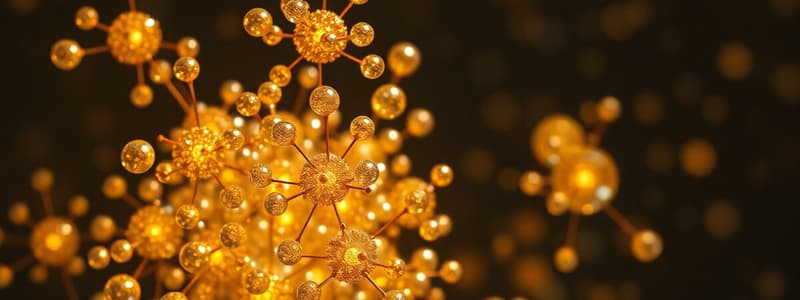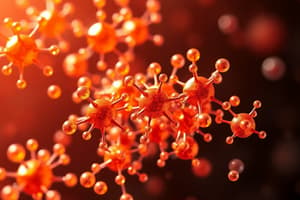Podcast
Questions and Answers
What are nanoclusters primarily composed of?
What are nanoclusters primarily composed of?
- Carbon aggregates
- Silver compounds
- Gold compounds (correct)
- Copper alloys
Which statement accurately describes nanoclusters?
Which statement accurately describes nanoclusters?
- They are large molecules with complex structures.
- They are isolated atoms with no aggregation.
- They are aggregates of atoms and molecules. (correct)
- They exist solely as single atomic units.
In the context of nanoclusters, what is a key characteristic?
In the context of nanoclusters, what is a key characteristic?
- They are always chemically inert.
- They are typically larger than micrometer-sized particles.
- They exist in a crystalline solid state.
- They can be formed from multiple elements. (correct)
Which of the following is NOT true about nanoclusters?
Which of the following is NOT true about nanoclusters?
Which aspect of nanoclusters enhances their potential applications?
Which aspect of nanoclusters enhances their potential applications?
Flashcards
Nanoclusters
Nanoclusters
Small groups of atoms or molecules.
Size of nanoclusters
Size of nanoclusters
Typically measured in nanometers.
Gold Nanoclusters
Gold Nanoclusters
Gold compounds that form nanoclusters.
What are nanoclusters composed of
What are nanoclusters composed of
Signup and view all the flashcards
Nanocluster properties
Nanocluster properties
Signup and view all the flashcards
Study Notes
Nanoclusters
- Nanoclusters are particles ranging in size from a few atoms to several thousand atoms.
- Nanoclusters are generally monodispersed particles that are less than 10 nm (100 Å) in diameter.
- High fraction of surface atoms gives them properties different from bulk materials.
- Different elements form different bonds and structures contributing to unique properties.
Nanocluster Properties
- EPR effect: A property of nanoclusters
- Renal clearance: A property of nanoclusters
- Biocompatibility: A property of nanoclusters
- Radiotherapy: A nanocluster application
- Photodynamic therapy: A nanocluster application
- Drug delivery: A nanocluster application
- Imaging-guided therapy: A nanocluster application
- Antimicrobial: Nanoclusters with antimicrobial activity (ROS)
Nanocluster Size and Structure
- Nanoclusters are smaller than nanoparticles.
- Geometric structures affect properties
- Electronic structures affect properties
- Size ranges from single atoms to 1nm to 5nm to 100 nm (nanoparticles)
Nanocluster Synthesis
- Made using laser vaporization technique.
- Laser focuses on metal sample causing evaporation.
- Atoms are cooled with inert gas flow.
- Atoms combine into clusters of varying sizes.
- Clusters are expanded into vacuum to cool further.
- Spectrometer measures the formed cluster.
Magic Numbers
-
Electronic Magic Number: The energy needed to remove an outer electron from an atom.
-
Highest ionization potential occurs in rare gases due to complete outer electron orbitals.
-
Peaks in ionization potential occur for clusters with 2 and 8 atoms
-
Structural Magic Number: Stability in larger clusters is determined by structure and magic number.
Theoretical Modeling of Nanoclusters
- Jellium Model: Nanocluster viewed as a large atom.
- Positive nuclear charge is uniformly distributed over a sphere, same size as cluster.
- Electron interaction with positive sphere is described as spherically symmetric
- Energy levels are calculated by Solving the Schrodinger Equation
Geometric Structures of Nanoclusters
- Bulk crystals may differ in lattice structures compared to smaller nanoclusters.
- Example: 80nm aluminum has Face-centered cubic (FCC) unit cell, while smaller nanoclusters may have different structure
- Gold nano-particles (3-5 nm) have icosahedral structure instead of bulk FCC
Other Properties and Applications
- Orbital calculations using density functional are applied, showing that icosahedral forms have the lowest energy in certain cases.
- Deviation from FCC (Face-centered cubic) structure occurs for clusters smaller than 8 nm in diameter
- Important to understand density of states in nanoclusters. Density of states represents number of possible electron energy levels within a range. Continuous density (found in large particle bulk materials) become a distinct set of energy levels in nanoclusters.
- Nanoclusters reactivity depends on size.
- Nanoparticles reactivity with oxygen can be studied using mass spectometer
- Reaction rate of iron with hydrogen is dependent on size
- High catalytic in nano-gold clusters (under 3-5nm) with icosahedral structure compared to bulk metals.
- Magnetic moments arise from electron spin and angular momentum in atoms.
- Atoms combine in nanoclusters resulting in a net magnetic moment
- Bulk properties appear in nanoclusters when the number of atoms exceeds a certain value (often 100+ for materials like copper and 1000+ for gold).
Studying That Suits You
Use AI to generate personalized quizzes and flashcards to suit your learning preferences.

